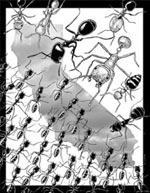Community Ecology of Invasions
Linepithema humile (Argentine ants) invasion in California
A central goal of invasion biology is to predict where introduced species will occur. Progress towards this goal requires an understanding of what factors limit invasion success and how they change in importance with spatial scale. Ecological communities, for example, differ greatly in the extent to which they become invaded; some appear relatively immune to invasion, whereas others are wholly transformed. Two broad categories of factors affect where introduced species will occur: the physical environment and species interactions. Because the outcomes of species interactions hinge on the environment in which they occur, it is essential to quantify how biotic and abiotic factors interact to influence spread and establishment of introduced species. Developing a comprehensive understanding of the factors governing community-level and ecosystem-level vulnerability to invasion remains an outstanding challenge in ecology and one of tremendous importance given that non-native species jeopardize ecosystems worldwide.
My research program combines experimental and spatial modeling approaches to address four interrelated questions using biological invasions.1) What is the relative importance of biotic and abiotic controls of invasion success? 2) How do biotic and abiotic factors change in importance with spatial scale? 3) Do invasive species differ from native species in their response to the abiotic environment? 4) How does the thoroughness of sampling and spatial grain of analyses affect the generalizations of species distribution models?
Most of my research is focused on a particularly damaging invader, the Argentine ant (Linepithema humile). Argentine ants are native to the subtropical riparian systems in eastern South America and have been introduced globally by humans. Argentine ants have been particularly successful in many of the world's Mediterranean-type ecosystems, where they disrupt ecosystems by displacing native species and by tending homoptera (such as aphids and scale insects). Linepithema humile invasions also incur tremendous economic costs in agriculture by tending homopter which indirectly damages crops and in urban setting as a common household pest. Moreover, introduced populations of Argentine ants are unicolonial, forming massive "supercolonies" that can extend for thousands of kilometers. The lack of aggression and territoriality within these supercolonies allows introduced populations to thrive and dominate in their introduced range. Because many other invasive and pest ants are also unicolonial, the factors that allow Argentine ants to become such successful invaders may also explain the success of many other invasive social insects.
PDF - Long-term record of Argentine ant invasions reveals enduring ecological impacts
PDF - Effects of aphids on foliar foraging by Argentine ants and the resulting effects on other arthropods
PDF - Biotic and abiotic controls of Argentine ant invasion success at local and landscape scales
PDF - Abiotic factors control invasion by Argentine ants at the community scale

